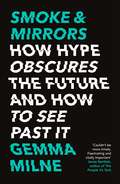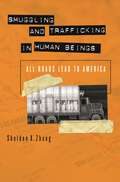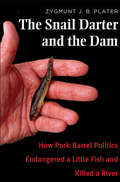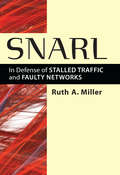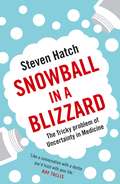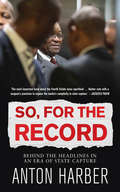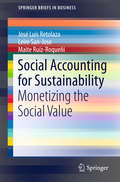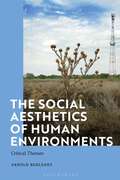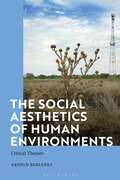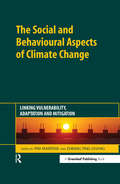- Table View
- List View
Smoke-Filled Rooms: A Postmortem on the Tobacco Deal (Studies in Law and Economics)
by W. Kip ViscusiThe 1998 out-of-court settlements of litigation by the states against the cigarette industry totaled $243 billion, making it the largest payoff ever in our civil justice system. Two key questions drove the lawsuits and the attendant settlement: Do smokers understand the risks of smoking? And does smoking impose net financial costs on the states? With Smoke-Filled Rooms,W. Kip Viscusi provides unexpected answers to these questions, drawing on an impressive range of data on several topics central to the smoking policy debate. Based on surveys of smokers in the United States and Spain, for instance, he demonstrates that smokers actually overestimate the dangers of smoking, indicating that they are well aware of the risks involved in their choice to smoke. And while smoking does increase medical costs to the states, Viscusi finds that these costs are more than financially balanced by the premature mortality of smokers, which reduces their demands on state pension and health programs, so that, on average, smoking either pays for itself or generates revenues for the states. Viscusi's eye-opening assessment of the tobacco lawsuits also includes policy recommendations that could frame these debates in a more productive way, such as his suggestion that the FDA should develop a rating system for cigarettes and other tobacco products based on their relative safety, thus providing an incentive for tobacco manufacturers to compete among themselves to produce safer cigarettes. Viscusi's hard look at the facts of smoking and its costs runs against conventional thinking. But it is also necessary for an informed and realistic debate about the legal, financial, and social consequences of the tobacco lawsuits. People making $50,000 or more pay .08 percent of their income in cigarette taxes, but people with incomes of less than $10,000 pay 1.62 percenttwenty times as much. The maintenance crew at the Capitol will bear more of the "sin tax" levied on cigarettes than will members of Congress who voted to boost it. Cigarettes are not a financial drain to the U.S. In fact, they are self-financing, as a consequence of smokers' premature mortality. The general public estimates that 47 out of 100 smokers will die from lung cancer because they smoke. Smokers believe that 40 out of 100 will die of the disease. Scientists estimate the actual number of 100 smokers who will die from lung cancer to be between 7 and 13.
Smoke-Filled Rooms: A Postmortem on the Tobacco Deal (Studies in Law and Economics)
by W. Kip ViscusiThe 1998 out-of-court settlements of litigation by the states against the cigarette industry totaled $243 billion, making it the largest payoff ever in our civil justice system. Two key questions drove the lawsuits and the attendant settlement: Do smokers understand the risks of smoking? And does smoking impose net financial costs on the states? With Smoke-Filled Rooms,W. Kip Viscusi provides unexpected answers to these questions, drawing on an impressive range of data on several topics central to the smoking policy debate. Based on surveys of smokers in the United States and Spain, for instance, he demonstrates that smokers actually overestimate the dangers of smoking, indicating that they are well aware of the risks involved in their choice to smoke. And while smoking does increase medical costs to the states, Viscusi finds that these costs are more than financially balanced by the premature mortality of smokers, which reduces their demands on state pension and health programs, so that, on average, smoking either pays for itself or generates revenues for the states. Viscusi's eye-opening assessment of the tobacco lawsuits also includes policy recommendations that could frame these debates in a more productive way, such as his suggestion that the FDA should develop a rating system for cigarettes and other tobacco products based on their relative safety, thus providing an incentive for tobacco manufacturers to compete among themselves to produce safer cigarettes. Viscusi's hard look at the facts of smoking and its costs runs against conventional thinking. But it is also necessary for an informed and realistic debate about the legal, financial, and social consequences of the tobacco lawsuits. People making $50,000 or more pay .08 percent of their income in cigarette taxes, but people with incomes of less than $10,000 pay 1.62 percenttwenty times as much. The maintenance crew at the Capitol will bear more of the "sin tax" levied on cigarettes than will members of Congress who voted to boost it. Cigarettes are not a financial drain to the U.S. In fact, they are self-financing, as a consequence of smokers' premature mortality. The general public estimates that 47 out of 100 smokers will die from lung cancer because they smoke. Smokers believe that 40 out of 100 will die of the disease. Scientists estimate the actual number of 100 smokers who will die from lung cancer to be between 7 and 13.
Smoke & Mirrors: How Hype Obscures the Future and How to See Past It
by Gemma Milne'Stop following the news until you've read Gemma Milne's persuasive analysis of the hype and bullshit that distort our understanding of emerging science. As she shows, the starting point to grasping the genuine opportunities of AI, life sciences and climate tech is a healthy dose of critical thinking'David Rowan, founding editor of WIRED UK and author of Non-Bullshit Innovation: Radical Ideas from the World's Smartest Minds'Couldn't be more timely. Fascinating and vitally important' Jamie Bartlett, author of The People Vs Tech 'A much-needed blast of fresh air! Gemma Milne expertly shows us how to separate the truth from the hype surrounding the emerging techs of today, and those of the near-tomorrow.' Lewis Dartnell, author of Origins: How the Earth Made Us'I loved this book! This is exactly the sort of sceptical, cut-through-the crap-but-still-excited-about-what's-emerging book around tech innovation that's sorely needed, yet is so hard to find . . . essential reading for anyone who's serious about how real-world advances might be effectively harnessed to build a better future.' Dr Andrew Maynard, scientist and author of Films from the Future and Future Rising'Smoke & Mirrors is a vital contribution in a world where technological progress promises so much, but too often disappoints. If, like me, you believe that advances in science and technology are our best hope for solving the grand challenges of our times, this book is the indispensable guide to avoiding the mirages and the charlatans along the way.' Matt Clifford, co-founder and CEO of Entrepreneur First'A refreshingly grown-up, clear-headed look at the interaction between science, technology and the media - readable without being dumbed down, acknowledging complexities without being heavy.' Tom Chivers, author of The AI Does Not Hate You'In this book, we see technological hype for what it is: not mere exuberance, but a form of attention-seeking. As some technological hucksters stake claims on our future and try to foreclose alternatives, we need strong defences. Gemma Milne offers a spotter's guide to hype, using science to bring speculation down to earth. People inside and outside the world of technological innovation need this book.' Jack Stilgoe, author of Who's Driving Innovation?'ROBOTS WILL STEAL YOUR JOB!''AI WILL REVOLUTIONISE FARMING!''GENETIC EDITING WILL CURE CANCER!'Bombastic headlines about science and technology are nothing new. To cut through the constant stream of information and misinformation on social media, or grab the attention of investors, or convince governments to take notice, strident headlines or bold claims seem necessary to give complex, nuanced information some wow factor.But hype has a dark side, too.It can mislead. It can distract. It can blinker us from seeing what is actually going on.From AI, quantum computing and brain implants, to cancer drugs, future foods and fusion energy, science and technology journalist Gemma Milne reveals hype to be responsible for fundamentally misdirecting or even derailing crucial progress.Hype can be combated and discounted, though, if you're able to see exactly where, how and why it is being deployed.This book is your guide to doing just that.
Smuggling and Trafficking in Human Beings: All Roads Lead to America
by Sheldon X. ZhangComing to America to make a better life has long been a dream of many from around the world, even if it means being smuggled into the country to gain entry. This book examines how human smuggling and trafficking activities to the United States are carried out and explores the legal and policy challenges of dealing with these problems. Zhang covers the scope and patterns of global human trafficking and smuggling activities; the strategies and methods employed by various groups to bring individuals into the United States; major smuggling routes and venues; the involvement of organized criminal organizations in transnational human smuggling activities; and the challenges confronting the U.S. government in combating these activities.
The Snail Darter and the Dam: How Pork-Barrel Politics Endangered a Little Fish and Killed a River (Wallace Stegner Lecture Ser.)
by Zygmunt Jan PlaterEven today, thirty years after the legal battles to save the endangered snail darter, the little fish that blocked completion of a TVA dam is still invoked as an icon of leftist extremism and governmental foolishness. In this eye-opening book, the lawyer who with his students fought and won the Supreme Court case—known officially as Tennessee Valley Authority v. Hill—tells the hidden story behind one of the nation’s most significant environmental law battles.The realities of the darter’s case, Plater asserts, have been consistently mischaracterized in politics and the media. This book offers a detailed account of the six-year crusade against a pork-barrel project that made no economic sense and was flawed from the start. In reality TVA’s project was designed for recreation and real estate development. And at the heart of the little group fighting the project in the courts and Congress were family farmers trying to save their homes and farms, most of which were to be resold in a corporate land development scheme. Plater’s gripping tale of citizens navigating the tangled corridors of national power stimulates important questions about our nation’s governance, and at last sets the snail darter’s record straight.
Snakes and Ladders for Property Professionals
by Frances Kaye Tanya RossThis book is for all those seeking to maximise the effectiveness of their professional relationships in order to reach the top of the property or construction industries. It is written to help young professionals at the early stages of their careers increase their understanding of others and to help more experienced practitioners gain additional skills on their way to the top. It guides you through the intricate steps of professional relationship building – internally for positive staff relationships and proactive teams as well as externally for smooth project management, delivery and business development. It contains advice that all ambitious professionals will find helpful: strategies to help you make the most of your strengths and optimise any opportunities that may present themselves. It is generously sprinkled with cases studies, some of which will cover familiar territory, others will act as a useful warning. Anyone choosing a career in the property and construction profession will benefit from reading this book. Whatever your level of seniority, the tips and tactics will help you to spot and avoid those slippery snakes and climb the ladders to the top.
Snakes and Ladders for Property Professionals
by Frances Kaye Tanya RossThis book is for all those seeking to maximise the effectiveness of their professional relationships in order to reach the top of the property or construction industries. It is written to help young professionals at the early stages of their careers increase their understanding of others and to help more experienced practitioners gain additional skills on their way to the top. It guides you through the intricate steps of professional relationship building – internally for positive staff relationships and proactive teams as well as externally for smooth project management, delivery and business development. It contains advice that all ambitious professionals will find helpful: strategies to help you make the most of your strengths and optimise any opportunities that may present themselves. It is generously sprinkled with cases studies, some of which will cover familiar territory, others will act as a useful warning. Anyone choosing a career in the property and construction profession will benefit from reading this book. Whatever your level of seniority, the tips and tactics will help you to spot and avoid those slippery snakes and climb the ladders to the top.
Snarl: In Defense of Stalled Traffic and Faulty Networks
by Ruth A MillerRuth A. Miller excavates a centuries-old history of nonhuman and nonbiological constitutional engagement and outlines a robust mechanical democracy that challenges existing theories of liberal and human political participation. Drawing on an eclectic set of legal, political, and automotive texts from France, Turkey, and the United States, she proposes a radical mechanical re-articulation of three of the most basic principles of democracy: vitality, mobility, and liberty. Rather than defending a grand theory of materialist or posthumanist politics, or addressing abstract concepts or “things” writ large, Miller invites readers into a self-contained history of constitutionalism situated in a focused discussion of automobile traffic congestion in Paris, Istanbul, and Boston. Within the mechanical public sphere created by automotive space, Snarl finds a model of democratic politics that transforms our most fundamental assumptions about the nature, and constitutional potential, of life, movement, and freedom.
Snowball in a Blizzard: The Tricky Problem of Uncertainty in Medicine
by Steven HatchLONGLISTED FOR THE THE BMA MEDICAL BOOK AWARDS According to a wry saying among radiologists, finding a tumour in a mammogram is like finding a snowball in a blizzard. Up to thirty percent of breast-cancer diagnoses are given to those who have no cancer at all. Medicine is subject to far more uncertainty than we commonly acknowledge. While it is portrayed a science, it can sometimes be scarily close to educated guesswork.Covering everything from the efficacy of Prozac to the regular barrage of health advice by the media, Snowball in a Blizzard is a profound meditation on why it's essential that doctors and their patients know what we don't know. The world is more complicated than we like to believe.Informed by years of frontline medical experience and filled with personal reflections, this important book is filled with counter-intuitive revelations about flawed reasoning, helpful guidance and hard-earned insight. It will change the way you view the health of yourself, your loved ones or your patients.
Snowfall at Willow Lake: Snowfall At Willow Lake Fireside Lakeshore Christmas (The Lakeshore Chronicles #4)
by Susan WiggsFill your winter with snowflakes, sparkles & Susan Wiggs
So, for the record: Behind the Headlines in an Era of State Capture
by Anton Harber‘Only Anton Harber, a pioneer of independent journalism in south Africa and one of the keenest observers of the media around, could have written the thriller that is this book.’ – Jacob DlaminiVeteran journalist Anton Harber brings all his investigative skills to bear on his very own profession, the media. For two years he conducted dozens of interviews with politicians, journalists, policemen, state security agents and ‘deep throats’, before piecing together two remarkable tales.The first is a chilling story of police death squads, rogue units and renditions, and how South Africa’s biggest newspaper was duped into doing the dirty work of corrupt politicians. The second starts with a broken and discarded hard drive and evolves, with many near misses, into the exposure of the depths of the Guptas’ influence over the ruling party.Harber’s two tales reveal the lows and highs of journalism during an era of state capture. His book is both a disquieting exposé of how easily the media can be duped by a conniving cabal for its own selfish ends, and a celebration of brilliant investigative reporting by brave and ethical journalists.
So, Now You Are an Arbitrator: The Arbitrator’s Toolkit
by Neil Kaplan Chiann BaoIn arbitration, procedure is crucial to ensure acceptance of the process. This book is about the importance of getting the procedure right. It begins with the first-ever request to be an arbitrator and takes the reader through all the stages of an arbitration. It points out some of the pitfalls and contains useful checklists. It gives advice on how to deal with conflicts, conduct hearings, deal with document requests, deal with experts, deal with challenges, agree on fees, draft procedural orders and awards, and how not to take on too much. Written by two experienced and highly respected international arbitrators, the book provides immeasurably valuable guidance on such details of the arbitral process as the following: terms of appointment; appointment of a tribunal secretary; steps to be taken before Procedural Order No. 1; written submissions; witnesses; third-party funding and contingency issues; keeping track of the money; interim measures; and expedited proceedings and early determination. Links to important documents are provided, and nineteen appendices include model forms for documents, agendas, orders, declarations, schedules, and protocols. Providing a veritable treasure trove of invaluable suggestions and hints which would only normally be known to arbitrators of many years’ standing, this eminently practical book will greatly enhance the ability of both new and experienced arbitrators to nip problems in the bud. It will also be of interest to counsel who appear in arbitrations and who may benefit from seeing things from the tribunal’s point of view. As this book will evolve into a ‘living’ book on the Kluwer website, the authors will continue to keep pace with developments in the field of international arbitration.
So Now You're Back (Mira Ser.)
by Heidi Rice‘Domestic Diva’ Halle Best is world famous as Queen of the Kitchen,and everything in her life is going perfectly. Until her ex comes back into the picture!
So you really want to be an Arbitrator?
by Mark CatoThis text provides a concise overview of arbitration and offers guidance on the most important legal and practical questions which face the practitioner involved in an arbitration. The book includes:- the applicability of the laws of individual countries; international conventions and bilateral treaties and their relevance to the arbitral process; the arbitration agreement and how an enforceable agreement can be created and enforced, with reference to both institutional arbitration, such as governed by AAA, ICC and LCIA and ad-hoc arbitration; and the arbitral process, from appointment of the tribunal to the award and its enforcement. The jurisdiction, powers and obligations of the tribunal are also examined in detail. The book also examines the role of UNCITRAL in overcoming the lack of unformity in the laws and rule relating to international commercial arbitration.
So you really want to be an Arbitrator?
by Mark CatoThis text provides a concise overview of arbitration and offers guidance on the most important legal and practical questions which face the practitioner involved in an arbitration. The book includes:- the applicability of the laws of individual countries; international conventions and bilateral treaties and their relevance to the arbitral process; the arbitration agreement and how an enforceable agreement can be created and enforced, with reference to both institutional arbitration, such as governed by AAA, ICC and LCIA and ad-hoc arbitration; and the arbitral process, from appointment of the tribunal to the award and its enforcement. The jurisdiction, powers and obligations of the tribunal are also examined in detail. The book also examines the role of UNCITRAL in overcoming the lack of unformity in the laws and rule relating to international commercial arbitration.
SOC for Supply Chain: Reporting on an Examination of Controls Relevant to Security, Availability, Processing Integrity, Confidentiality, or Privacy in a Production, Manufacturing, or Distribution System, 2020 (AICPA)
by AICPAInternal and external forces such as globalization, global interconnectivity, automation, and other technological advancements are making today’s supply chains highly sophisticated and complex. For organizations that produce, manufacture or distribute products, there’s often a high level of interdependence and connectivity with their suppliers and their customers and business partners. Although the interconnectedness of these organizations can be beneficial (increased revenues, expanded market opportunities, and cost reduction), the ability of organizations to meet their goals is often increasingly dependent on events, processes, and controls that are not visible and are often beyond their control – such as a supplier’s controls. That’s why the demand for transparency in supply chains is now higher than ever before, and why this is the perfect time for you to help organizations assess their supply chain risks, evaluate the system controls within their manufacturing, production, or distribution systems, and communicate their supply chain management efforts to those with whom they do business. Accountants and financial managers can also increase the credibility of the supply chain information communicated by the organization by providing an opinion on the organization’s supply chain efforts. This guide enables the accountant and financial manager to examine and report on the description of a system for manufacturing, producing and distributing goods as well as on the controls within that system using a dynamic, proactive, and agile approach. It will show how to conduct this examination in accordance with the attestation standards. The guide may also be helpful when providing readiness assessments to clients, who are not quite ready for an examination level service and need help to get there. The guide also includes excerpts from the two distinct, but complementary sets of criteria developed by the AICPA to assist practitioners with SOC for Supply Chain engagements: the description criteria and the 2017 trust services criteria.
SOC for Supply Chain: Reporting on an Examination of Controls Relevant to Security, Availability, Processing Integrity, Confidentiality, or Privacy in a Production, Manufacturing, or Distribution System, 2020 (AICPA)
by AICPAInternal and external forces such as globalization, global interconnectivity, automation, and other technological advancements are making today’s supply chains highly sophisticated and complex. For organizations that produce, manufacture or distribute products, there’s often a high level of interdependence and connectivity with their suppliers and their customers and business partners. Although the interconnectedness of these organizations can be beneficial (increased revenues, expanded market opportunities, and cost reduction), the ability of organizations to meet their goals is often increasingly dependent on events, processes, and controls that are not visible and are often beyond their control – such as a supplier’s controls. That’s why the demand for transparency in supply chains is now higher than ever before, and why this is the perfect time for you to help organizations assess their supply chain risks, evaluate the system controls within their manufacturing, production, or distribution systems, and communicate their supply chain management efforts to those with whom they do business. Accountants and financial managers can also increase the credibility of the supply chain information communicated by the organization by providing an opinion on the organization’s supply chain efforts. This guide enables the accountant and financial manager to examine and report on the description of a system for manufacturing, producing and distributing goods as well as on the controls within that system using a dynamic, proactive, and agile approach. It will show how to conduct this examination in accordance with the attestation standards. The guide may also be helpful when providing readiness assessments to clients, who are not quite ready for an examination level service and need help to get there. The guide also includes excerpts from the two distinct, but complementary sets of criteria developed by the AICPA to assist practitioners with SOC for Supply Chain engagements: the description criteria and the 2017 trust services criteria.
Social Accounting for Sustainability: Monetizing the Social Value (SpringerBriefs in Business)
by José Luis Retolaza Leire San-José Maite Ruíz-RoqueñiThis book deals with the limitations of economic and financial accounting as an appropriate instrument to reflect the real value created or destroyed by an organization. The authors present a sustainable social accounting approach that considers both the social and economic value – Blended Value – generated by an organization for all of its stakeholders. This approach is based on four major theories – Stakeholder Theory, Action Research, Phenomenological Perspective and Fuzzy Logic – and was developed on the basis of a cost-benefit analysis.
The Social Aesthetics of Human Environments: Critical Themes
by Arnold BerleantAcross these essays Arnold Berleant demonstrates how aesthetic values and theory can be used to reappraise our social practices. He tackles issues within the built environment, everyday life, and politics, breaking down the dichotomy between the natural and the human. His work represents a fresh approach to traditional philosophical questions in not only ethics, but in metaphysics, truth, meaning, psychology, phenomenology, and social and moral philosophy. Topics covered include the cultural aesthetics of environment, ecological aesthetics, the aesthetics of terrorism, and the subversion of beauty. The corruption of taste by the forces of commercial interests as well as how aesthetics can advance our understanding of violence are also considered. Berleant's exploration is supported by his analysis of 19th-century art to the present day, starting with impressionism through to postmodernism and contemporary artistic interventions. By critically examining the field in this way and casting new light on social understanding and practice, this collection makes a substantive contribution in identifying and clarifying central human issues, guided by an understanding of aesthetic engagement as a powerful tool for social critique.
The Social Aesthetics of Human Environments: Critical Themes
by Arnold BerleantAcross these essays Arnold Berleant demonstrates how aesthetic values and theory can be used to reappraise our social practices. He tackles issues within the built environment, everyday life, and politics, breaking down the dichotomy between the natural and the human. His work represents a fresh approach to traditional philosophical questions in not only ethics, but in metaphysics, truth, meaning, psychology, phenomenology, and social and moral philosophy. Topics covered include the cultural aesthetics of environment, ecological aesthetics, the aesthetics of terrorism, and the subversion of beauty. The corruption of taste by the forces of commercial interests as well as how aesthetics can advance our understanding of violence are also considered. Berleant's exploration is supported by his analysis of 19th-century art to the present day, starting with impressionism through to postmodernism and contemporary artistic interventions. By critically examining the field in this way and casting new light on social understanding and practice, this collection makes a substantive contribution in identifying and clarifying central human issues, guided by an understanding of aesthetic engagement as a powerful tool for social critique.
The Social and Behavioural Aspects of Climate Change: Linking Vulnerability, Adaptation and Mitigation
by Pim Martens Chiung Ting ChangOver the past few years, and certainly since the publication of the "Stern Report", there has been increasing recognition that climate change is not only an environmental crisis, but one with important social and economic dimensions. There is now a growing need for multi-disciplinary research and for the science of climate change to be usefully translated for policy-makers.Until very recently, scientific and policy emphasis on climate change has focused almost exclusively on mitigation efforts: mechanisms and regulations to reduce greenhouse gas emissions. The success of such efforts to date is debatable. In fact, the impact of ever more stringent emission control programmes could potentially have enormous social consequences. Little effort has been expended on the exploration of a systematic evaluation of climate stabilization benefits or the costs of adapting to a changed climate, let alone attempting to integrate different approaches. There is an increasing recognition that the key actors in the climate crisis also need to be preparing for change that is unavoidable. This has resulted in a greater consideration of vulnerability and adaptation.The book, based on the research programme "Vulnerability, Adaptation and Mitigation" (VAM) which ran from 2004 to 2010, funded by the Netherlands Organisation for Scientific Research (NWO), presents a cluster of case studies of industries, communities and institutions which each show how vulnerability, adaptation and mitigation analyses can be integrated using social behavioural sciences. Each chapter makes specific recommendations for the studied industry sector, community or institution, analyses the latest research developments of the field and identifies priorities for future research. The book argues that the inherent complexity of climate change will ultimately require a much more integrated response both scientifically – to better understand multiple causes and impacts – as well as at the scientific/policy interface, where new forms of engagement between scientists, policy-makers and wider stakeholder groups can make a valuable contribution to more informed climate policy and practice.The book is particularly timely as the scientific research and policy debate is shifting from one of problem-framing to new agendas that are much more concerned with implementation, the improvement of assessment methodologies from a multi-disciplinary perspective, and the reframing of current scientific understanding towards mitigation, adaptation and vulnerability. A critical element in responding to the climate change challenge will be to ensure the translation of these new scientific insights into innovative policy and practice "on the ground". This book provides some fundamental elements to answer this need.The Social and Behavioural Aspects of Climate Change: Linking Vulnerability, Adaptation and Mitigation will be essential reading for social science researchers and policy managers in the area of climate change, as well as for those who want to know what the social and behavioural sciences can contribute toward coping with climate hazards. NGOs, law firms and businesses in the energy sector or other climate related fields will also find the book of great value.
The Social and Behavioural Aspects of Climate Change: Linking Vulnerability, Adaptation and Mitigation
by Pim Martens Chiung Ting ChangOver the past few years, and certainly since the publication of the "Stern Report", there has been increasing recognition that climate change is not only an environmental crisis, but one with important social and economic dimensions. There is now a growing need for multi-disciplinary research and for the science of climate change to be usefully translated for policy-makers.Until very recently, scientific and policy emphasis on climate change has focused almost exclusively on mitigation efforts: mechanisms and regulations to reduce greenhouse gas emissions. The success of such efforts to date is debatable. In fact, the impact of ever more stringent emission control programmes could potentially have enormous social consequences. Little effort has been expended on the exploration of a systematic evaluation of climate stabilization benefits or the costs of adapting to a changed climate, let alone attempting to integrate different approaches. There is an increasing recognition that the key actors in the climate crisis also need to be preparing for change that is unavoidable. This has resulted in a greater consideration of vulnerability and adaptation.The book, based on the research programme "Vulnerability, Adaptation and Mitigation" (VAM) which ran from 2004 to 2010, funded by the Netherlands Organisation for Scientific Research (NWO), presents a cluster of case studies of industries, communities and institutions which each show how vulnerability, adaptation and mitigation analyses can be integrated using social behavioural sciences. Each chapter makes specific recommendations for the studied industry sector, community or institution, analyses the latest research developments of the field and identifies priorities for future research. The book argues that the inherent complexity of climate change will ultimately require a much more integrated response both scientifically – to better understand multiple causes and impacts – as well as at the scientific/policy interface, where new forms of engagement between scientists, policy-makers and wider stakeholder groups can make a valuable contribution to more informed climate policy and practice.The book is particularly timely as the scientific research and policy debate is shifting from one of problem-framing to new agendas that are much more concerned with implementation, the improvement of assessment methodologies from a multi-disciplinary perspective, and the reframing of current scientific understanding towards mitigation, adaptation and vulnerability. A critical element in responding to the climate change challenge will be to ensure the translation of these new scientific insights into innovative policy and practice "on the ground". This book provides some fundamental elements to answer this need.The Social and Behavioural Aspects of Climate Change: Linking Vulnerability, Adaptation and Mitigation will be essential reading for social science researchers and policy managers in the area of climate change, as well as for those who want to know what the social and behavioural sciences can contribute toward coping with climate hazards. NGOs, law firms and businesses in the energy sector or other climate related fields will also find the book of great value.
Social and Economic Rights in Africa: International and Public Law Perspectives (Routledge Studies on Law in Africa)
by Nsongurua UdombanaSocial and economic rights have hitherto been marginalised in mainstream legal and political discourses and treated as second-class citizens in the human rights family. These rights are now receiving increasing attention in law and politics, arguably because they raise existential questions on human security and dignity. This one-stop volume examines the international and public law perspectives on socio-economic rights in Africa. Working on the premise that these rights are normative and justiciable, the author methodically and expertly examines the legal frameworks for their protection in global, regional, and national instruments, infusing the analysis with African and comparative jurisprudence. The author also examines the nature of obligations on these rights as well as the interpretive methodologies that should be deployed towards their realisation. In blending theory with practice, the book also refl ects on some governance challenges that continue to hobble the eff ective realisation of these rights in Africa. The book is a seminal contribution on an important fi eld, an ideal companion for human rights practitioners, international and constitutional lawyers, judges, government advisors, students, social workers, and everyone who desires ‘freedom from fear and want’.
Social and Economic Rights in Africa: International and Public Law Perspectives (Routledge Studies on Law in Africa)
by Nsongurua UdombanaSocial and economic rights have hitherto been marginalised in mainstream legal and political discourses and treated as second-class citizens in the human rights family. These rights are now receiving increasing attention in law and politics, arguably because they raise existential questions on human security and dignity. This one-stop volume examines the international and public law perspectives on socio-economic rights in Africa. Working on the premise that these rights are normative and justiciable, the author methodically and expertly examines the legal frameworks for their protection in global, regional, and national instruments, infusing the analysis with African and comparative jurisprudence. The author also examines the nature of obligations on these rights as well as the interpretive methodologies that should be deployed towards their realisation. In blending theory with practice, the book also refl ects on some governance challenges that continue to hobble the eff ective realisation of these rights in Africa. The book is a seminal contribution on an important fi eld, an ideal companion for human rights practitioners, international and constitutional lawyers, judges, government advisors, students, social workers, and everyone who desires ‘freedom from fear and want’.
Social and Economic Rights in Theory and Practice: Critical Inquiries (Routledge Research in Human Rights Law)
by Helena Alviar García Karl Klare Lucy A. WilliamsSince World War II, a growing number of jurisdictions in both the developing and industrialized worlds have adopted progressive constitutions that guarantee social and economic rights (SER) in addition to political and civil rights. Parallel developments have occurred at transnational level with the adoption of treaties that commit signatory states to respect and fulfil SER for their peoples. This book is a product of the International Social and Economic Rights Project (iSERP), a global consortium of judges, lawyers, human rights advocates, and legal academics who critically examine the effectiveness of SER law in promoting real change in people’s lives. The book addresses a range of practical, political, and legal questions under these headings, with acute sensitivity to the racial, cultural, and gender implications of SER and the path-breaking SER jurisprudence now emerging in the "Global South". The book brings together internationally renowned experts in the field of social and economic rights to discuss a range of rights controversies from both theoretical and practical perspectives. Contributors of the book consider specific issues in the litigation and adjudication of SER cases from the differing standpoints of activists, lawyers, and adjudicators in order to identify and address the specific challenges facing the SER community. This book will be of great use and interest to students and scholars of comparative constitutional law, human rights, public international law, development studies, and democratic political theory.

